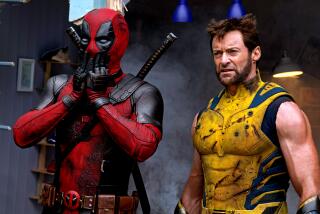Sound Wars Coming to a Theater Near You : Technology: Rival Japanese firms are using summer movies to launch digital systems that promise to create CD-like sound.
- Share via
If you thought the big movie choice of the summer was pretty basic--Schwarzenegger or Spielberg, rad car chases or virtually real dinosaurs--you obviously haven’t factored in sound quality.
In the race for the box office crown, the rival Japanese electronics companies that produced the two movies expected to be this summer’s biggest hits are using the films to launch dueling digital sound systems, both of which promise to bring CD-like sound to movie theaters.
In a special showing Monday of a trailer from director Steven Spielberg’s “Jurassic Park,” Matsushita-owned Universal Pictures touted its Digital Theater Sound as cheaper and easier to install than competitor Sony Corp.’s system, which is being used in this summer’s “Last Action Hero.”
But Sony, still smarting from the loss of the key VHS-Betamax videotape formatting battle with Matsushita in the early 1980s, says it does not intend to let history repeat itself. Both studios will have to contend with Dolby Laboratories, whose digital sound format premiered last summer with “Batman Returns.”
The impending sound war underscores the growing importance of technology in luring movie-goers confronted with a widening range of entertainment options. With the specter of 500 TV channels and expanded pay-per-view service in the near future, movie studios areincreasingly enlisting computer power to help nudge audiences into theaters.
“We need to let our consumers understand that this is bigger and broader and better than anything you can play at home, and you have to come to the theater to get it,” says James Fiedler, president of Sony Dynamic Digital Sound.
Fiedler acknowledges that the under-$4,000 Universal system is less expensive than Sony’s, which will come closer to Dolby’s $20,000 price tag. But Universal’s DTS is not imprinted on the film; it is packaged instead as a separate CD-ROM disc, to be played on a separate machine using a digital time code on the film. That, says Fiedler, opens the possibility of all sorts of disasters.
“It would be pretty interesting to watch the opening of ‘Jurassic Park’ and hear the latest Claude van Damme dialogue coming out of a dinosaur’s mouth, wouldn’t it?”
But Dan Slusser, general manager of Universal City Studios, notes that film has long been distributed in several cans. For thousands of dollars less, theaters can keep track of one more can, he says.
Dolby President Bill Jasper says his company has an advantage because it is not associated with any one studio. Dolby digital sound will be available this summer on Disney’s “Super Mario Brothers,” Fox’s “Rising Sun” and Universal’s “Dragon,” among others.
But all three acknowledge that there will likely be one standard in the end. “History has shown that only one format has ever come to dominate, and I think that will happen here too,” Jasper says.
Digital sound, of course, is nothing new. For more than a decade, the music industry has been translating sound waves into computer code to achieve more precise sound quality. But while nearly half of all American households own compact disc players, only a few hundred U.S. theaters are equipped to play digital soundtracks.
Studio executives blame the delay in bringing no-hiss, super-clear sound to theaters in part on the difficulty in adapting high-tech sound technology to what is essentially an ancient, low-tech process of making film. The other problem, they say, has been in persuading theater owners--and the public--that they can hear the difference and that it is worth paying for.
Indeed, Optical Radiation Corp. invested $10 million in a digital sound format it developed jointly with Eastman Kodak Co., only to jettison the business in 1991 after failing to interest enough theater owners and studios. One problem was that the technology did not include the traditional analog sound, which meant studios had to maintain a double inventory and, if a theater’s digital equipment failed, there was no fallback.
Sony, Universal and Dolby all include analog soundtracks along with digital, although Universal executives hint that they may eventually go to a digital-only format. But interesting theater owners may still be a significant hurdle. Universal, whose system is by far the least expensive of the three, has signed up only 1,000 theaters for the launch of the digital “Jurassic Park.” Sony has far fewer. And only 200 theaters are now equipped with Dolby’s digital system, which has been available for nearly a year.
“I don’t think there’s an upside to us getting involved with this at all,” said one executive at a major theater chain who asked not to be identified. “You’ve got all these different systems out there, which one do you buy? What if you buy Sony and it turns out not to be the standard?”
More to Read
The biggest entertainment stories
Get our big stories about Hollywood, film, television, music, arts, culture and more right in your inbox as soon as they publish.
You may occasionally receive promotional content from the Los Angeles Times.










